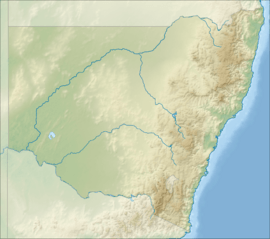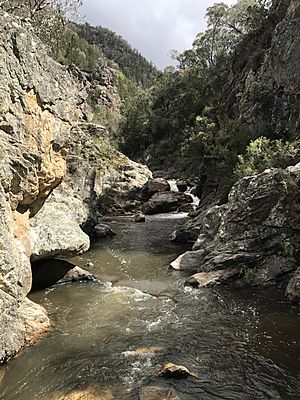Wee Jasper Nature Reserve facts for kids
Quick facts for kids Wee Jasper Nature ReserveNew South Wales |
|
|---|---|
|
IUCN Category Ia (Strict Nature Reserve)
|
|
| Nearest town or city | Wee Jasper |
| Established | November 1979 |
| Area | 6.3 km2 (2.4 sq mi) |
| Managing authorities | NSW National Parks and Wildlife Service |
| Website | Wee Jasper Nature Reserve |
| See also | Protected areas of New South Wales |
The Wee Jasper Nature Reserve is a special protected area in New South Wales, Australia. It's like a natural park where plants and animals are kept safe. This reserve is located in a part of NSW called the Southern Tablelands. It covers about 630 hectares, which is roughly the size of 1,500 football fields! You can find it west of the Goodradigbee River, close to the Burrinjuck Dam and the small town of Wee Jasper.
Contents
What Makes Wee Jasper Special?
The Wee Jasper Nature Reserve was created in 1979 to protect its unique environment. Over the years, more land has been added to it. This helps keep more of the natural habitat safe for all the creatures and plants that live there. The reserve is managed by the NSW National Parks and Wildlife Service, who work hard to look after it.
Amazing Plants of Wee Jasper
The reserve is home to four different types of forest. Each forest has its own mix of trees and grasses, depending on things like how much sun it gets and where it's located.
- Apple Box and Norton's Box Forests: These forests grow on slopes that face southeast. They have lots of grass and stay quite moist.
- Brittle Gum and Broad-leaved Peppermint Forests: You'll find these trees on slopes that face east and get a good amount of sun.
- Norton's Box and Poa Grass Forests: These forests are on the west-facing slopes in the southern part of the reserve.
- River She-oak Forests: These special trees grow right along Wee Jasper Creek, enjoying the water nearby.
Rare and Endangered Plants
Some plants in the Wee Jasper Nature Reserve are very rare or are in danger of disappearing forever. Scientists work to protect them.
- Australian Anchor Plant (Discharia pubescens) and Limestone Brittle-moss (Orthotrichum cupulatum) are both very rare.
- The Yass Daisy (Ammobium craspedioides) is considered vulnerable. This means it needs protection to survive.
- The Wee Jasper Grevillea (Grevillea iaspicula) and the Formbe Pepper-cress (Lepidium pseudopapillosum) are even more at risk. They are listed as endangered, meaning they are in serious danger of becoming extinct.
Wonderful Animals of Wee Jasper
The reserve is a safe home for many different animals. So far, scientists have found about 60 different kinds of animals living here! This includes various mammals, birds, reptiles, and amphibians. Protecting their habitat helps them thrive.



